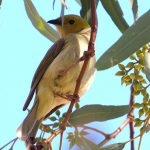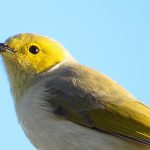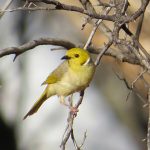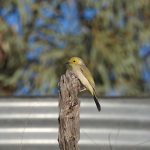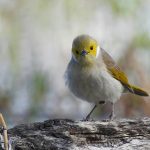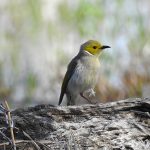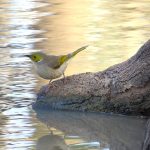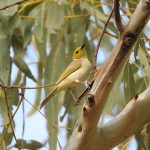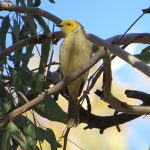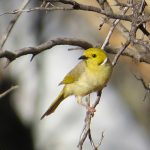WHITE-PLUMED HONEYEATER
Ptilotula penicillata
The White-plumed Honeyeater
At first light along a river red gum, the air is cool and smells of damp bark and eucalyptus oil. From the canopy comes a bright, metallic chipping—quick, lively notes that seem to skip over the water. A small olive-green bird flits between blossom and leaf, pausing just long enough for the morning to catch a flash of white on its cheek. That neat, snowy plume—like a fine brushstroke beneath the ear—gives the White-plumed Honeyeater its name and makes it one of the most familiar voices of inland Australia.
Quick facts
| Feature | Details |
|---|---|
| Scientific name | Ptilotula penicillata |
| Size | About 15–17 cm in length |
| Distinctive mark | A crisp white “plume” along the side of the neck/cheek |
| Colour | Olive-green above, grey to pale underparts with a soft yellow wash on the face |
| Call | Bright, metallic chips and trills; sharp scolding notes when alarmed |
| Range | Widespread across mainland Australia, most common inland and along waterways; absent from Tasmania |
| Status | Least Concern (common and adaptable) |
How to recognise one
- Look for an olive-green honeyeater with a clean, white plume curving along the side of the head.
- The face is softly yellow; the bill is slender and dark; the eye is dark with a fine pale rim.
- In flight, it moves in short, buoyant bursts, often between flowering eucalypts.
- Listen for bright, tinkling calls delivered from exposed perches, especially at dawn.
Where they live
White-plumed Honeyeaters are birds of eucalypt country, favouring:
- River corridors lined with red gums and coolibahs
- Open woodlands, mallee edges, and tree-lined paddocks
- Town parks, gardens, schoolyards and golf courses with mature native trees and reliable water
They are especially associated with water in otherwise dry landscapes, often forming bustling neighbourhoods around creeks, billabongs and farm dams.
Daily life and behaviour
- Social and assertive: They live in loose colonies and can be bold at water sources, chasing even larger birds away from favoured perches.
- Foraging style: They glean insects and lerps (the sweet shelters of psyllid bugs) from leaves and twigs, probe blossoms for nectar, and sometimes sally out to snatch flying insects.
- Voice: Their repertoire ranges from bright, musical chips to rapid scolds when a predator—such as a butcherbird or a cuckoo—comes too close.
Diet: sweet and protein-rich
- Nectar from eucalypts and other native blossoms fuels their energy.
- Insects, spiders, and lerps provide protein for growth and breeding.
- By carrying pollen on their foreheads and faces, they quietly pollinate the trees they feed from—an essential ecological partnership.
Breeding
- Season: Mostly late winter to summer in the south, but flexible after good rain inland.
- Nest: A neat, hanging cup woven from plant fibres and spider web, often suspended in the outer foliage of a small branch.
- Clutch: Usually 2–3 eggs, pale with fine speckling.
- Defence: Pairs—and sometimes their neighbours—vigorously mob intruders near the nest. They are known to be targeted by small cuckoos, which occasionally parasitise their nests.
Similar species you might confuse them with
- Yellow-faced Honeyeater: A coastal and tableland species with a distinct yellow eye-stripe and white crescent under the eye, not a solid white cheek plume.
- Singing Honeyeater: Browner overall with a heavier bill and a dark line through the eye; more common in arid and coastal shrublands.
- Noisy Miner: Much larger, grey, with yellow eye-skin and a loud, chattering presence in suburbs.
Field tips for better views
- Stand quietly near flowering eucalypts or a lightly shaded water point; the scent of nectar and the soft rustle of leaves often betrays an active feeding bird.
- Early morning is best: the music of their calls carries clearly in the cool air, and the white plume shows well in slanting light.
- Watch for brief hover-feeding at blossoms and quick sallies out from a perch to snatch insects.
Conservation in context
The White-plumed Honeyeater is adaptable and common, but it thrives best where:
- Mature native trees provide nectar, insects and nesting sites
- Understorey shrubs offer cover for small birds
- Water sources are clean and shaded
Challenges include clearing of riverine woodlands, removal of understorey, and the spread of aggressively dominant species in simplified habitats. Healthy, layered vegetation supports a richer community where small honeyeaters can coexist.
How you can help
- Plant local native trees and shrubs, especially eucalypts, callistemons and melaleucas, to provide nectar year-round.
- Keep a bird-safe water dish: shallow, shaded, cleaned regularly, with a nearby shrub for cover.
- Retain understorey where possible; a mix of heights gives small birds places to feed and retreat.
- Keep cats indoors or in secure outdoor enclosures, particularly during nesting months.
- Avoid sugar-water feeders; natural plantings are healthier and support a wider web of life.
A parting image
As the day warms, the gum blossoms release a stronger perfume, and the canopy hums with insects. A White-plumed Honeyeater darts through dappled light, a bright stitch of movement against the leaves. It pauses, plume gleaming, and pours out a tumble of notes that ripple across the water—small, persistent, and vital, like the riverside forests it helps to keep alive.


